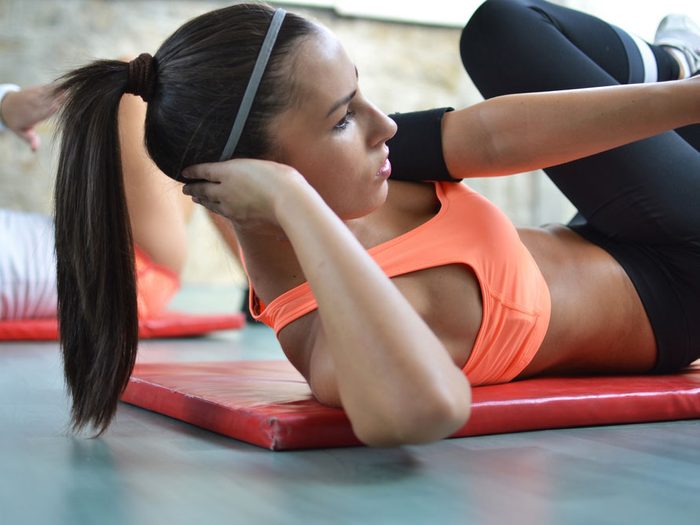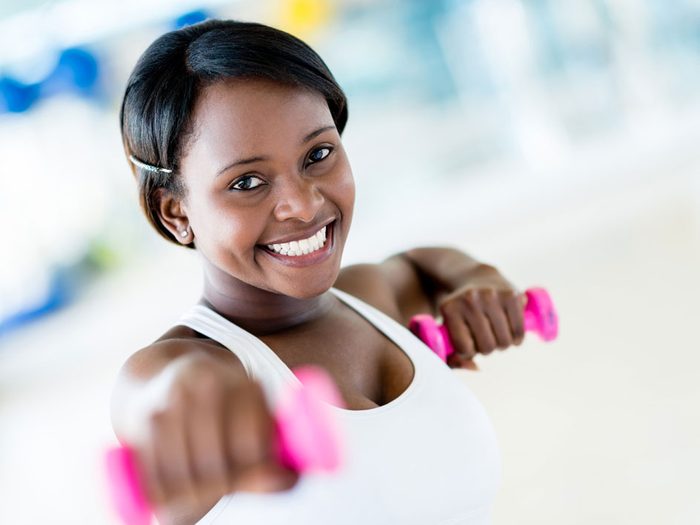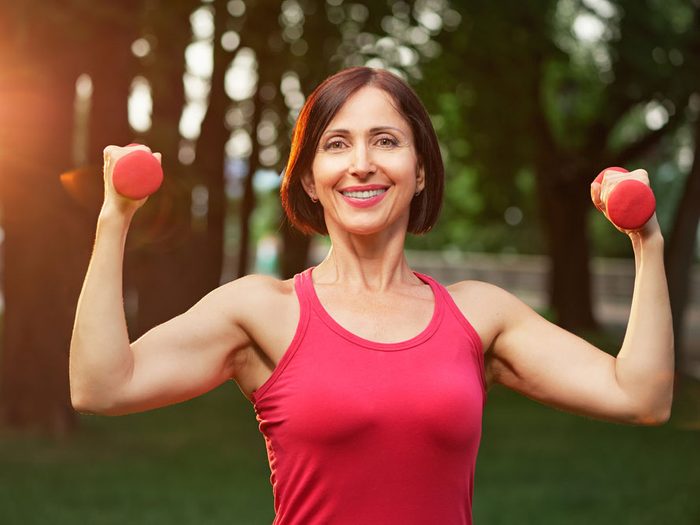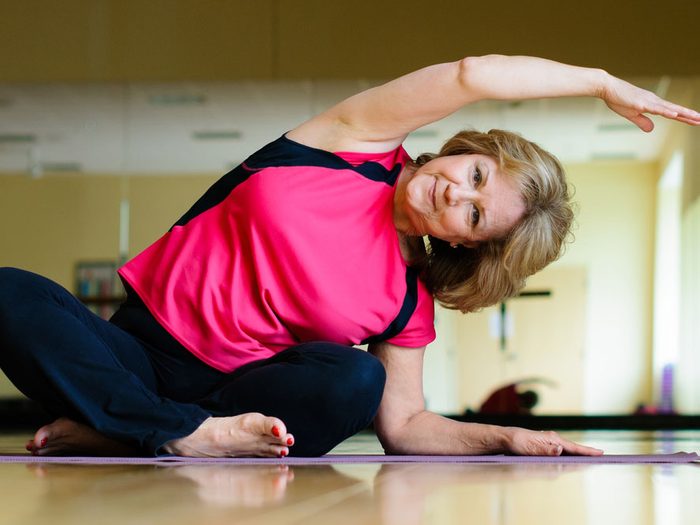
Exercise: The Best Anti-Ager
Want to look and feel your best well into your 40, 50s, 60s and beyond? Forget about spending money on the latest anti-aging creams and lotions. Instead, invest your time and energy in an exercise plan.
“If you’re involved in regular physical activity, you are doing some really amazing things for your body,” says Dr. Greg Wells, an assistant professor in the faculty of kinesiology and physical education at the University of Toronto.
For starters, the very act of breathing harder has an impact on better health. You breathe harder, says Dr. Wells, because your body needs oxygen to improve all aspects of your oxygen transport pathways, including your lungs, heart and muscles. “Exercise helps make almost every tissue in your body healthier and better,” he says. That means feeling and looking better inside and out – a veritable fountain-of-youth effect.
In fact, says Jonathan P. Little, an assistant professor and a specialist in exercise physiology at the University of British Columbia, Okanagan, recent studies on exercise and aging are changing the way we think about getting older. “There’s research to suggest that maybe what we think of as normal aging – losing fitness and muscle mass – has more to do with inactivity,” says Little. “As you age, you tend to not be as active, so maybe some of what we thought was the aging process is just a lack of activity.”
In addition, says Dr. Wells, there’s evidence that links regular physical activity to a decreased risk of chronic illnesses, such as cardiovascular disease, Type 2 diabetes, Alzheimer’s and certain types of cancer. And the good news is, you don’t have to run marathons to reap the benefits. Walking, cycling, swimming, yoga, golf and other lifestyle activities will boost your body and your brain. The key, say the experts, is consistency.
With that in mind, here’s a look at how exercise can keep you healthy, fit and looking and feeling younger, whatever your age.

In Your 30s: Make Habits
If you got physical in your 20s, don’t stop now. According to Little, it’s all too easy to lose the healthy benefits that exercise brings. One study took healthy young males and reduced their daily steps from approximately 10,000 to just 1,500. Within two weeks, they began to lose fitness levels and insulin sensitivity and gained abdominal fat, he says. “You essentially start to show signs of metabolic syndrome – or Type 2 diabetes – within a very short period of time.”
And just how much should you exercise? Well, if you’re moderately active and looking to push yourself further, the general recommendation is 60 minutes a day, five or six times a week, says Dr. Wells. But for those just starting out, he’s quick to dismiss those guidelines. “I realize that’s a lot for the vast majority of the population,” he says. “Eighty-five percent of our population doesn’t exercise enough to prevent chronic illness, so I really don’t worry about those numbers. What I do say to people is that consistency is everything.”
As Allana LeBlanc, a certified exercise physiologist and physical activity expert at ParticipACTION, points out, you can start small. “We recommend exercise in bouts of at least 10 minutes at moderate to vigorous intensity,” she says. The intensity gauge is your ability to have a conversation while being active. For moderate intensity, you should be able to carry on a conversation, even though you’re breathing harder. Your intensity would be considered vigorous if you’re struggling to talk during your activity.
Adding activity in your 30s will have immediate benefits, from improving heart health and building muscle to strengthening bones and improving sleep and mood. And it helps down the road by lowering your risk of so-called age-related diseases, such as osteoporosis, Alzheimer’s and diabetes.

In Your 40s: Don’t Stop Now
“This is the stage of life for many where careers are really taking off – a time when work is critical,” says Dr. Wells. “People often sacrifice exercise because they’re busy, but it’s one of the most important times to exercise.” Why? Because exercise helps your brain, too. “There’s fantastic research showing that exercise can increase your ability to learn, concentrate and focus – all the sorts of things you need to do your job well,” says Dr. Wells.
It will also help keep your weight in check – something many of us need to be more mindful of as we age. Fifty-eight percent of Canadians are overweight or obese, and that means rising levels of Type 2 diabetes, high blood pressure and higher risk of stroke, cancer and osteoarthritis.
While exercise on its own may not take off the pounds, it will improve your longevity. “Even without weight reduction, physical activity will really help with high blood pressure, high cholesterol and Type 2 diabetes,” says LeBlanc. “These are really what will hurt you in your later life and make it harder to do the things you want to do.”
Dr. Wells agrees: “I don’t worry about weight; I worry about body composition. I want us to have more muscle and less fat, as that leads to better health. To do that, we need to keep exercising as we age.” That includes some kind of cardiovascular exercise (walking, swimming, running, cycling), as well as some form of strength training for muscle and bone maintenance. Flexibility training is also important. Bonus: You know those fine lines and wrinkles that tend to crop up in your 40s? Research shows that exercise can help with those, too.

In Your 50s and Beyond: Protect Your Health
Still active? Give yourself a pat on your toned back – especially if you’ve kicked things up a notch and made getting regular, vigorous activity a priority. Your reward might even show in your DNA.
A recent study of runners aged 55 to 72 found that the length of their telomeres (the protective caps on the strands of DNA that keep them from fraying – think plastic tips on the ends of shoelaces) were virtually the same as those of 18- to 32-year-olds. Meanwhile, sedentary people in that same 55- to 72-year-old age group had shorter telomeres.
“As we age, the telomeres shorten and the DNA begins to fray,” says Dr. Wells. “Errors begin to accumulate in our DNA, and this is one of the reasons why it’s believed our bodies begin to deteriorate as we age.” Regular exercise can, in fact, keep you young – right down to your cells.
But even if you missed the movement boat up until your 50s, it’s not too late to start and gain benefits. “At any age – even in your 90s – people can gain fitness, muscle mass and strength from doing exercise,” says Little. “You’re never too old to gain the benefits of exercise from a scientific and lifestyle point of view.”
LeBlanc agrees: “There isn’t a tipping point for when this is especially beneficial or when all is lost,” she says. “You can reap the benefits of physical activity throughout your life.” The key is to find something you enjoy and to do it at least three times a week. “It can’t just be something you do on the weekends,” emphasizes Dr. Wells. “It has to be built into your life as a major priority because consistency makes all the difference in the world. It doesn’t matter how much you do; it matters how consistent you are.” He says that using just one percent of your day – about 15 minutes – for activity can make a huge difference in your life.
“Exercise in your 50s and beyond is really about protecting your health,” he says. “It’s about setting you up so you can continue to live a world-class life. People now don’t want to approach retirement and play shuffleboard and bridge. They want to go out and travel the world, be active, play golf and squash and play with their grandkids. They want an active, healthy, high-performance life, and that’s highly possible if you keep exercising.
Skin Deep
Why do some of the fittest 60-plus women look younger than their age? The answer lies in the question. A recent study from McMaster University in Hamilton, ON, found that women over 65 who worked out for a minimum of two hours a week for three months had the skin composition of women 20 to 30 years younger. It seems that sweating it out at the gym leads to pumping myokines, a group of proteins secreted by muscle cells and diffused throughout the body. The result: younger-looking complexions. So, the message is clear: For the best anti-aging remedy, hit the gym.
